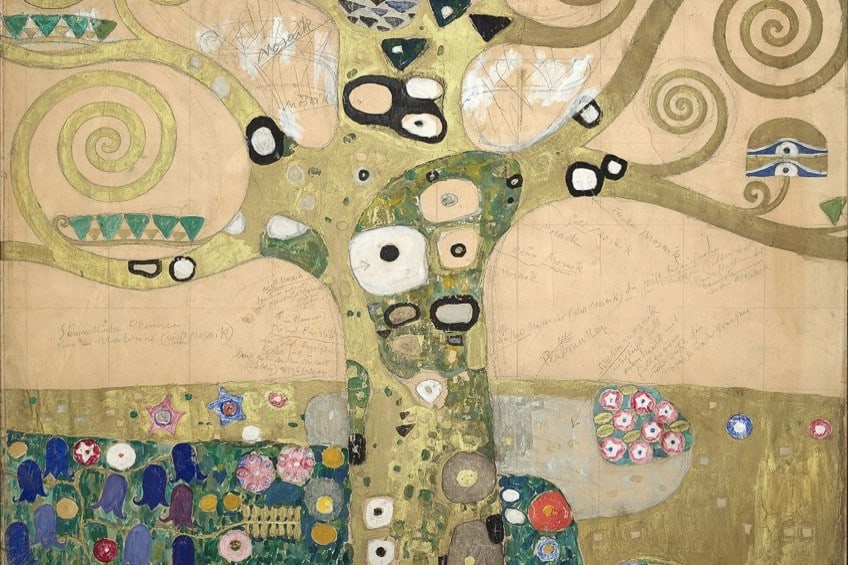“Tree of Life” by Gustav Klimt – Explore the “Tree of Life” Painting
Gustav Klimt is known for his luminescent gold and lushly patterned paintings. The most famous of these paintings were created in the last few years of his career, in a period called the Golden Period – the Tree of Life painting being one of the most well-known. In this article, we will do a formal analysis of the Tree of Life by Gustav Klimt. As well as look at the socio-political context it was created in and other questions like “Where is Gustav Klimt’s Tree of Life located?”
Contents
Artist Abstract of Gustav Klimt
| Date of Birth | 14 July 1862 |
| Date of Death | 6 February 1918 |
| Country of Birth | Baumgarten, Austrian Empire |
| Associated Art Movements | Symbolism, Art Nouveau, Vienna Secession movement |
| Art Style | Decorative style of painting |
| Mediums Used | Painting, drawing, objets d’art |
| Dominant Themes | Eroticism, women, and the “femme fatale” |
After tragedy struck the Viennese artist Gustav Klimt when his father and younger brother died in the same year (1892), his life and art changed forever. Before this point in his career, Klimt had gotten training at the Vienna School of Arts and Crafts.
He received a scholarship for this training because he already showed a lot of talent before the age of fourteen.
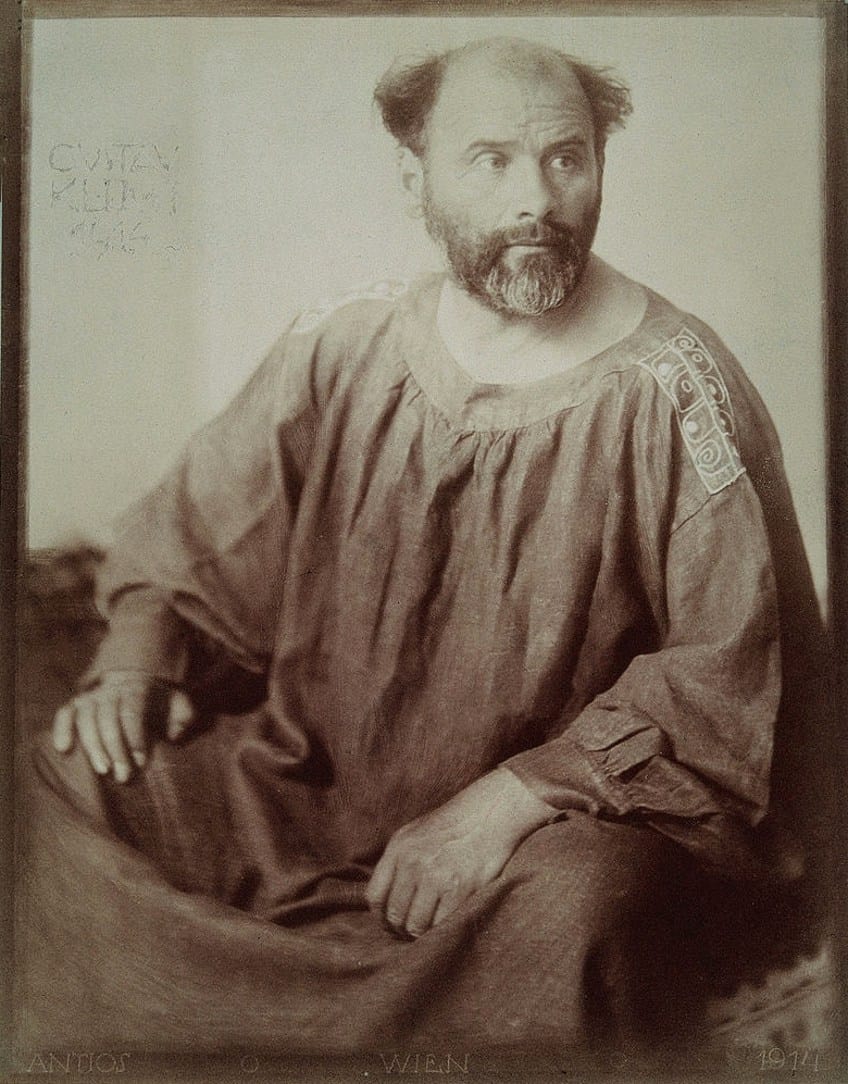
After completing his studies, he painted in the popular and traditional naturalistic painting style. But after the death of his family members, Klimt became more interested in developing a unique style that would also establish Austria as a cultural center of art.
Klimt became obsessed with love and death in his work, and even though he was a closed-off man, his art started showing a deep-thinking and feeling man beneath the famously promiscuous artist.
When he started incorporating the inspirations from his travels, early life with his gold-carver father, and his first independent studio days with his meal-worker brother into the style now called the “Golden Period”, Klimt immortalized himself in the history of art.
Looking at The Tree of Life (1909) by Gustav Klimt
The Tree of Life is one of Gustav Klimt’s most important and impactful paintings. It captures the artist’s unique style of vibrant colors, patterns, decorative shapes, and symbolic meaning. The painting also caused a lot of controversy at the time it was shown to the world for the first time. Let us do an in-depth analysis of this stunning artwork.
| Artist | Gustav Klimt |
| Date Painted | 1909 |
| Medium | Oil and gold leaf on canvas |
| Type of Painting | Figure painting |
| Dimensions (cm) | 195 × 102 |
| Series / Versions | The painting is a study for a series of mosaics called the Stoclet Frieze. |
| Location | Museum of Applied Arts, Vienna, Austria |
Socio-Historical Context of Tree of Life by Gustav Klimt
At the time the Tree of Life painting was created, Vienna, Austria (Gustav Klimt’s lifelong home) was fraught with tension between conservative opinions and modern liberal views. It was just after the turn of the century and all that kept the city (and country) from erupting into violence at that time was the rich cultural scene that created a patriotic spirit in Vienna.
During these last convulsions of the Belle Époque, Klimt forged a new style of painting that openly addressed sexuality and desire.
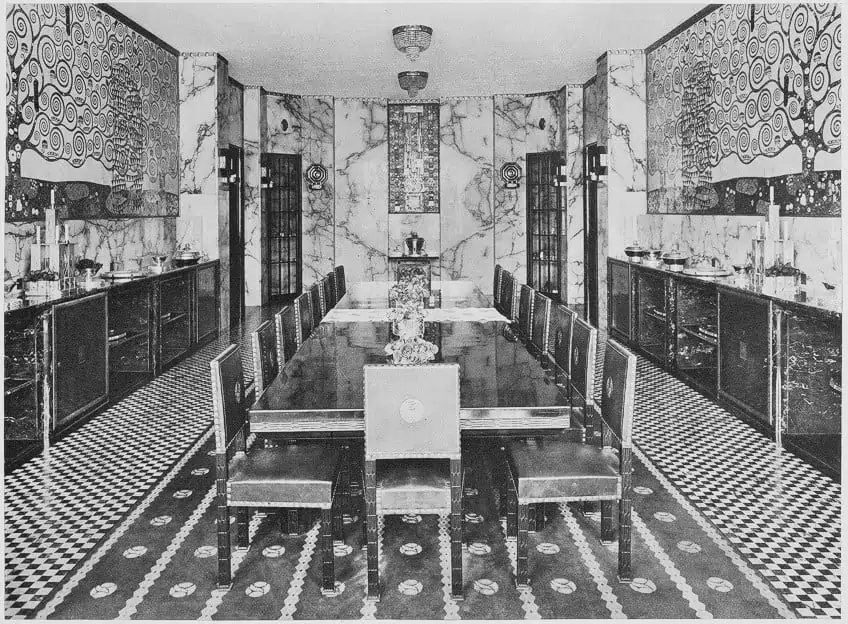
Before, this was simply not done. His art caused controversy, at exactly the right moment for him (and the world). The outrage at his “blasphemous” and “pornographic” work led other artists to break the stale boundaries of the art academy even further and helped usher in a brand-new era of art history.
Formal Analysis: A Compositional Overview
The Tree of Life painting shows the famous symbol used in theology, philosophy, myth, and literature. The intricate painting depicts a woman on the left side looking over her shoulder at a couple embracing on the far-right side of the painting.
Her body is turned away from the lovers, but her upper body is fully turned towards them- her interest keenly fixed on the intimate scene.
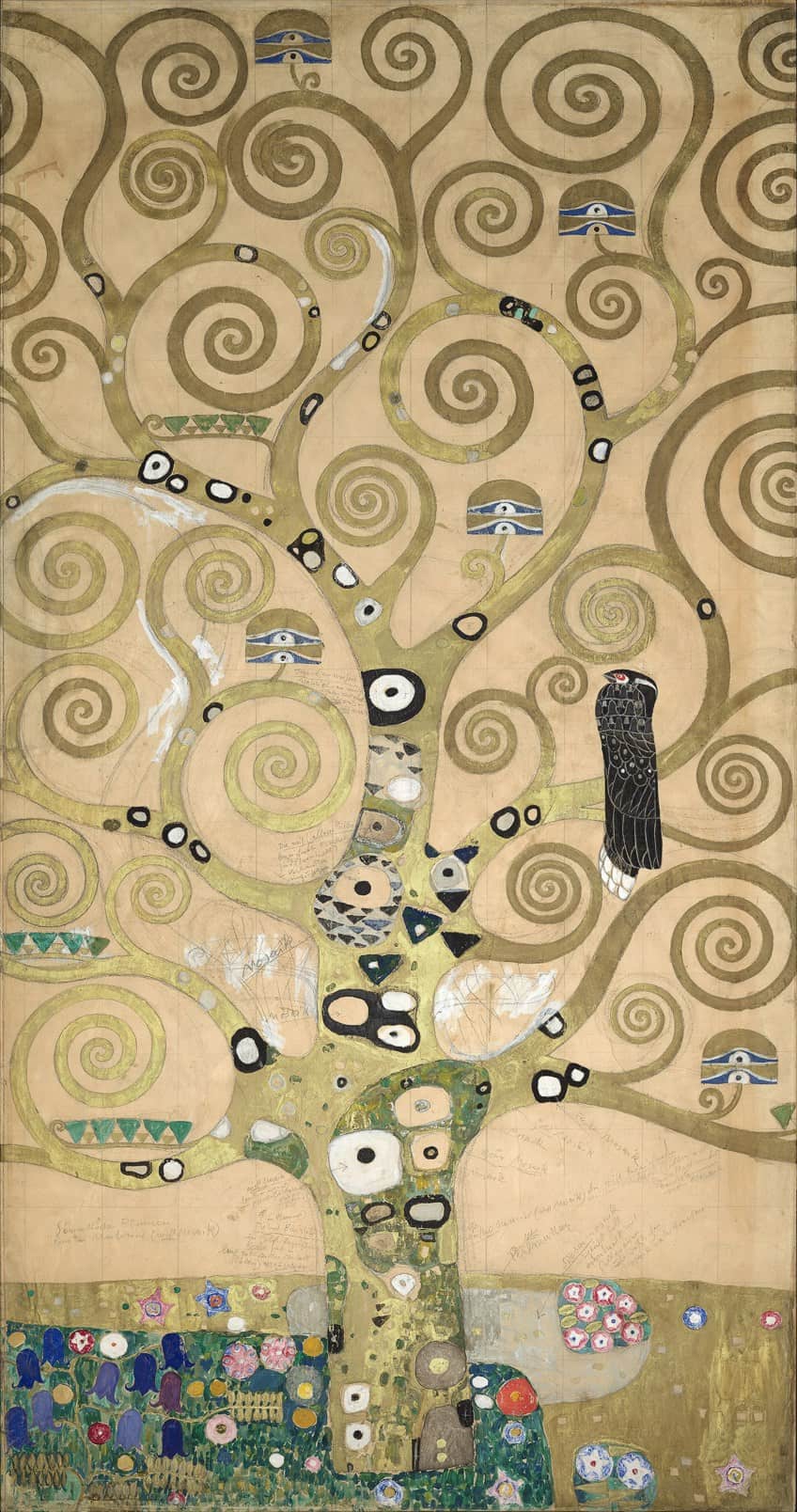
The lovers mirror the famous couple in The Kiss painting by Gustav Klimt, created parallel to the Tree of Life. The painting continues themes of love, desire, union, and intimacy Klimt explored in The Kiss. There is a tree in the middle composition and its elaborate branches fill the background of the scene.
This sets the painting apart from The Kiss and other paintings of his Golden era, as it is the only landscape painting Klimt created during this phase of his career.
Subject Matter
The subject matter of the painting is captured in the title. The Tree of Life signifies the connection between heaven and Earth but also speaks to the cycle of life. Klimt, therefore, explores here the birth, life, and death cycle of human experience. The Tree of Life is one of the few paintings in Klimt’s career that depicts that masculine and feminine forms. It is significant in this painting as it indicates the unity created through love.
The yearning look of the woman standing on her own can represent the yearning people have to find love.
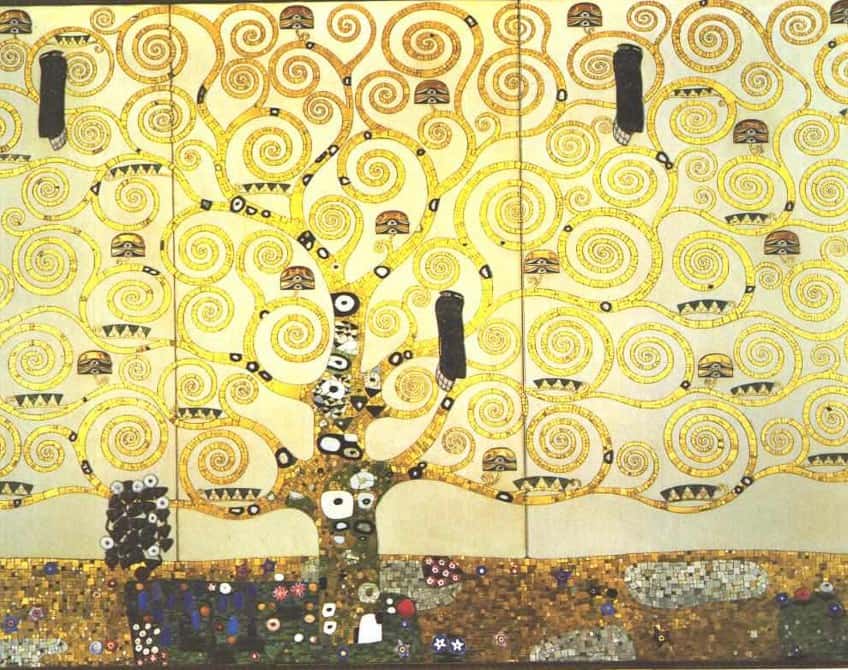
The embracing couple, then, represents the satisfaction of the unity of intimate love and is suggestive that finding this kind of love is the purpose of life. The couple – similar to those painted in The Kiss – dissolves into each other with their garments barely distinguishable from one another. From this symbolic embrace, life is born.
The subject matter of this painting is, therefore, the origin, purpose, and trajectory of life.
Color, Pattern, and Form
The bold color, pattern, and form are used to support the striking subject matter of the Tree of Life painting. These elements, which became synonymous with the name Gustav Klimt, are what make this artwork still so impactful today. The Golden Period in Klimt’s work was inspired by the gold-carving work his father did in his childhood, and the metal work his younger brother Ernst did while they ran a studio together after Klimt had finished his studies.
That being said, the Golden Period was only really catalyzed in Klimt’s style after he did two trips to Ravenna, Italy.
The impact the Byzantine sacred art had on Klimt altered his career forever and is evident in the (almost) over-the-top use of gold and silver leaf. The decorative influence of Byzantine mosaics is also obvious in the detailed use of inorganic shapes saturating the composition. He packs the painting full of patterns, using big triangles for the lonely woman’s dress, erect squares and rectangles for the male’s kaftan, and smaller shapes for the embraced woman’s dress.
The tree’s branches are vibrant swirls, suggesting a kind of movement or energy captured in the painting – as if the tree is growing in front of your eyes.
This intense use of patterns and decorative forms echoes the influence of the Arts and Crafts movement of the era on Klimt’s work (as on most avant-garde artists of the time). This is also indicative of the influence of the Art Nouveau movement on his unique style development. Furthermore, the gold in this painting reminds us of Middle Ages religious art that had lavish gold trimmings.
Perspective and Space
Another common characteristic of Klimt’s Golden Period paintings is visible here in the Tree of Life painting – a flattened composition with almost no spatial perspective. As in The Kiss, the lovers painted here melt into a background. The patterns and shapes of their garments are only slightly different from that of the background.
The even use of color and gold also adds to this flattened composition, with barely any strong contrasts or shadows included.
The way Gustav Klimt painted his patterns and shapes also resulted in a tension between two- and three-dimensionality, this adds to the abstraction of perspective. He painted the faces and hands of the figures in a quite naturalistic style, contrasting them heavily against the simplified shapes and patterns of the background and garments. This is one of the only reasons why the figures truly stand apart from the background. Besides this naturalistic element and the tree, is very few other indications that the figures are in a landscape.
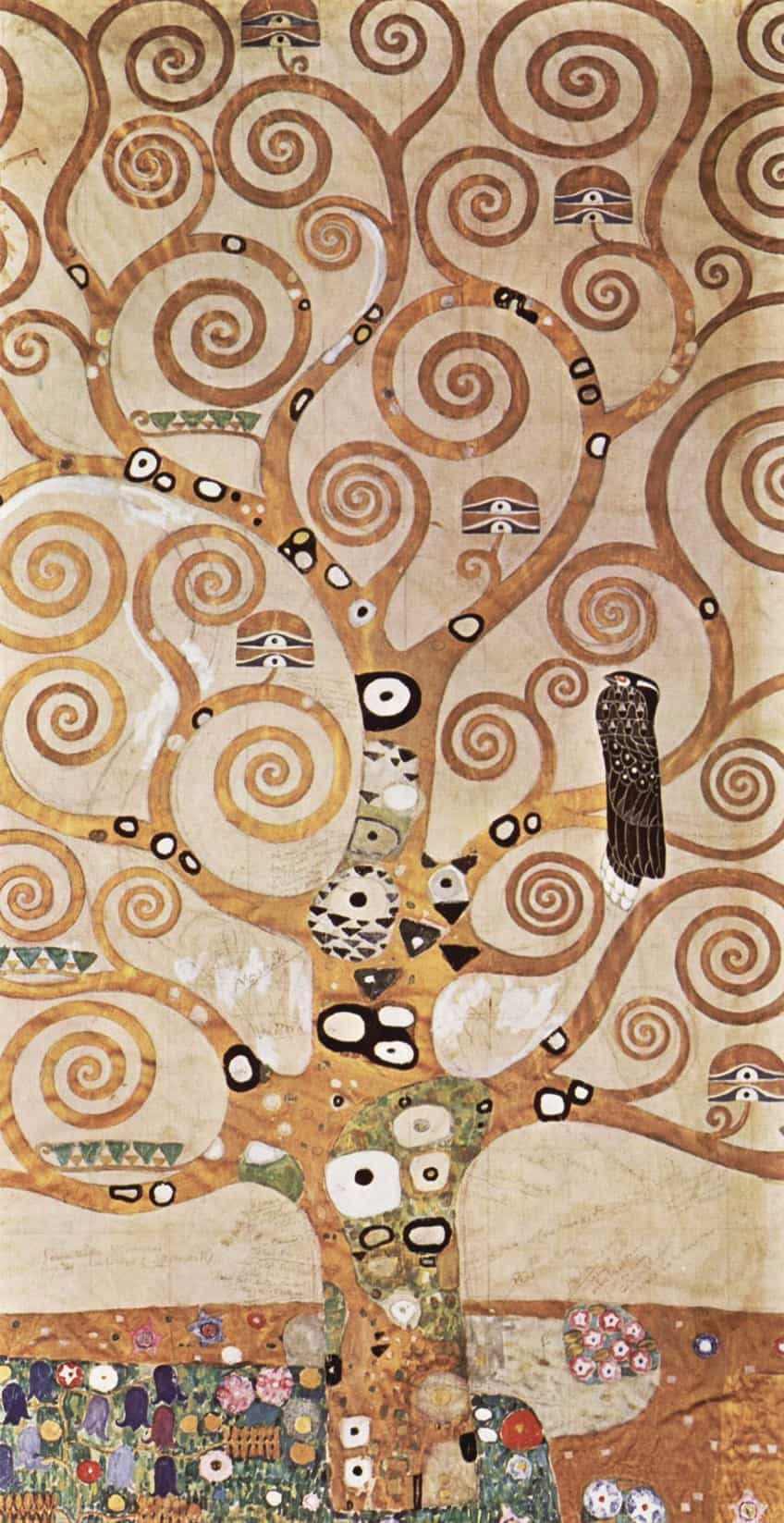
The flat mosaics Klimt found so inspiring in the Church of San Vitale in Ravenna added to his creating these flat, almost mosaiced scenes. At the time Klimt created this painting, Europe was full of ground-breaking styles, like Cubism, Pointillism, and the first signs of Abstract art. This mix of ways to push the boundaries of traditional painting influenced Klimt. The avant-garde art movements were also inspired by accessible traveling modes that opened up the world of travel to these creatives.
As with the Cubists, the influence of Japanese prints is evident in Klimt’s Golden Period as he drew inspiration from the way they painted flat areas of color and barely suggested perception or space.
This influence goes further in the Tree of Life painting, as the top of the painted elements (the tree and figures) end very close to the top of the painting. This cropping was not standard in traditional European art, and was, therefore, very strange to Klimt’s audience. Revolutionary, in fact.
Symbolism and Style
The tree in the middle of the painting is a symbol of the connection between Earth and heaven. It has a transcendent quality, which the gold leaf adds to. The gold and silver use gives the painting a sacred feel, and the symbol of the Tree of Life also adds to this spiritual experience of the painting. The tree’s branches, swirling spiral, symbolize the endlessness of the cycle of life.
The intricate network of branches consisting of twisting forms that undulate over and under each other is symbolic of the complexity of life.
The tree is rooted in the earth, indicating death and what is underneath the experience of life – the underworld. Death is further suggested by a single blackbird, drawing the eye to the middle of the composition in an uncomfortable way, as this bird motif is not repeated at all in a composition filled with repetitive patterns. The feminine form shown in the painting represents nourishment, fertility, and expansion.
The male representation is echoed in phallic shapes and symbolizes the completion of the union needed to sprout life – a union needed to catalyze the growth of the Tree of Life.
The Impact of the Tree of Life by Gustav Klimt
It is important to understand, as, with most masters in art history, that white European men had the most support, time, and resources to pursue and develop their art. It then makes sense why Klimt, amongst his other boundary-pushing peers, had such an influence on the trajectory of the Western art canon.
That being said, Klimt had a massive impact on the artists to follow him as he was one of the first artists to explore sexuality, desire, and an erotic subconscious in painting.
The Tree of Life draws you in while challenging the viewer with an overwhelming visual experience. You have to spend a bit more time with it before the meaning becomes apparent. This impulse to linger that the massive painting stimulates, combined with the fact that it so directly shows the intimate union of a man and a woman – shocked its Austrian audience. But this overwhelming effect is what continued its success into the contemporary moment.
View our “Tree of Life” by Gustav Klimt web story here.
Frequently Asked Questions
Where Is Gustav Klimt’s Tree of Life Located?
The Tree of Life (1909) is located at the Museum of Applied Arts in Vienna, Austria. This impressive painting is visited yearly by thousands of art lovers. It is, along with The Kiss, one of Klimt’s most impactful art pieces.
What Makes the Tree of Life Painting So Impressive?
The Tree of Life (1909) is a very large painting, with the figures being life-sized. Along with the size, the color use of lavish gold and silver leaf, and striking patterns, make the viewing experience of this painting overwhelmingly impressive.
What Is the Symbolism of the Tree of Life?
Created in 1909, Gustav Klimt’s Tree of Life painting shows the famous symbol used in theology, philosophy, myth, and literature. It speaks to the cycles of life, with Klimt finding the origin and meaning of life in the embrace of lovers – in the union of the masculine and feminine.
Nicolene Burger, a South African multimedia artist and creative consultant, specializes in oil painting and performance art. She earned her BA in Visual Arts from Stellenbosch University in 2017. Nicolene’s artistic journey includes exhibitions in South Korea, participation in the 2019 ICA Live Art Workshop, and solo exhibitions. She is currently pursuing a practice-based master’s degree in theater and performance. Nicolene focuses on fostering sustainable creative practices and offers coaching sessions for fellow artists, emphasizing the profound communicative power of art for healing and connection. Nicolene writes blog posts on art history for artfilemagazine with a focus on famous artists and contemporary art.
Learn more about Nicolene Burger and about us.
Cite this Article
Nicolene, Burger, ““Tree of Life” by Gustav Klimt – Explore the “Tree of Life” Painting.” artfilemagazine – Your Online Art Source. December 19, 2022. URL: https://artfilemagazine.com/tree-of-life-by-gustav-klimt/
Burger, N. (2022, 19 December). “Tree of Life” by Gustav Klimt – Explore the “Tree of Life” Painting. artfilemagazine – Your Online Art Source. https://artfilemagazine.com/tree-of-life-by-gustav-klimt/
Burger, Nicolene. ““Tree of Life” by Gustav Klimt – Explore the “Tree of Life” Painting.” artfilemagazine – Your Online Art Source, December 19, 2022. https://artfilemagazine.com/tree-of-life-by-gustav-klimt/.


